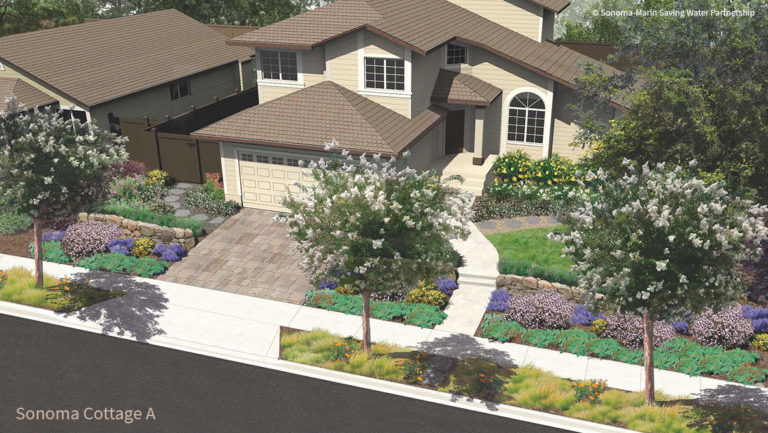Like the thousands of other people who lost their homes in the October 2017 firestorms that tore through Santa Rosa and the Sonoma Valley, Janis Powers also lost virtually everything growing around her house.
Gone were the hydrangea and the daphne flourishing against her garage. Ditto for the rosebushes that grew between her yard and her neighbor’s yard. All that survived of her cutting plants were a few bulbs.
“I love to pick flowers and bring them in the house,” said Powers, who had been living in her Coffey Park home exactly 23 years when it was destroyed by the Tubbs fire. Happily, she and her husband, Pat, moved into their newly rebuilt home Sept. 1.
And thanks to the efforts of the Sonoma County Water Agency, Petaluma’s nonprofit Daily Acts, and a cadre of volunteers, her front yard will soon be as fresh and new as her house.
Powers is one of four people selected to receive a free landscaping installation using a design based on a template created by the Sonoma- Marin Water Saving Partnership, a consortium of 12 water agencies that works together to come up with regional solutions for reducing water use.
The Powers are responsible for purchasing the plants and other materials. But the design was free and on Oct.12, volunteers will converge on her home and three others in Coffey Park to lay irrigation and put plants in the ground. When it is done, Powers will have two walkways — one from the sidewalk and one from the driveway — mulch, decorative rock, a sitting area and plants like French lavender that are drought hardy and won’t require a lot of water once they get established.
There are eight different designs to choose from among four key design concepts: a Sonoma Native Garden with an emphasis on native and fire-safe plants, the Sonoma Eco-Edible plan, with a mix of edible and habitat plants, the Sonoma Contemporary, a modern, minimalistic plan designed for easy maintenance, and the Sonoma Cottage, inspired by a relaxed English cottage garden but Sonoma-style with natural materials and colorful plantings. Each style has a plan for a small lot and a large lot.
The program was developed to meet the needs of fire victims. But the plans are free and available online for use by anyone at Savingwaterpartnership.org. The site also includes information about consulting with a trained Landscape Design Template advisor to adapt a plan for one’s individual lot. Many homeowners had their house insured but not necessarily their landscape. It ended up being another cost they didn’t anticipate,” said Ann Baker, a Petaluma landscape architect who was the lead designer and consultant for the project. Baker assembled a team of local designers, landscape contractors, civil engineers and the nonprofit Daily Acts, that teaches and promotes sustainable living, to help create the templates and engage the public in the design process.
Under normal circumstances, professional landscape design services can cost thousands of dollars, and that is before the first shovel goes into the ground, she added.
Many people also didn’t realize that new homes now require a permit for a front yard landscape. And since many of the homes in Coffey Park were built, the state developed stricter water efficiency laws for landscaping, Baker said. For many, the yard became just one more thing heaped onto the monumental task of rebuilding a home from the ground up.
The city of Santa Rosa and the Sonoma County Water Agency saw the program as a way of helping fire victims while also seizing the opportunity to create more new landscapes that are water efficient. That included plants and trees that use less water and eco-amenities like rainwater harvesting systems, permeable paving and rainwater gardens that capture water in swales to reduce runoff and replenish the water table.
“What we were trying to do is get ahead of people getting to the point where they were putting in their gardens,” Baker said. “What we didn’t want is for people to start rolling out sod because it was too late in the game.”
A team of professionals contributed, including Sherwood Design Engineers, to help with rainwater gardens.
As of July 1, 43% of the 504 landscape plans submitted for rebuilds have been based off the Landscape Design Templates, said Elise Howard, communications coordinator for Santa Rosa Water.
“These design plans are available to anyone and also serve as a resource to support the city’s WaterSmart program goals for outdoor water-use efficiency,” she said.
It is estimated that just under 25,000 gallons of water is saved every year for every 1,000 square feet of turf that is replaced with low-water-use plants, according to Brian Lee, with the Sonoma County Water Agency. With so many homes being rebuilt, the potential water savings was great.
The plans were drawn up taking into account the typical smaller city lots of Coffey Park and generally larger lots in the Mark West area, and feedback from people at community workshops.
“We want people to plan their gardens. We want them to consider bird habitat and be attractive and able to provide groundwater storage. And we need shade and street trees,” Baker said.
The designs also incorporate concepts of defensible space to reduce the threat of a fire spreading through their landscape to the house. That includes walkways and hardscaping like patios nearest the house and adequate spacing between plants, also good to prevent weeds, which are a fire hazard. Plants are spaced away from walls, and trees are separated from shrubs to keep fire from laddering up into tree canopies. Other features being encouraged are decorative metal gates and fencing or hogwire or wire trellising for fencing rather than wood, particularly touching the house.
“These show you can be fire safe and have nice habitat gardens and have it be beautiful as well,” Baker said.
The plans are scalable for landscapes up to 2,500 square feet, and homeowners can choose their style. The Eco-Edible garden includes fruit trees and shrubs that are attractive and also provide food.
“We’ve had a lot of interest in eco-edible landscaping,” Baker said. “We put as much information into the design as possible so you can feel confident you can do it without a high level of knowledge. We’re also hoping to create a maintenance manual with the Water Agency to give people more information about how to establish their landscapes and maintain them in the first five years.”
The Native Adaptive plan features a lot of California native plants, shrubs and trees, as well as perennial grasses and wildflowers, and aims to be very low water use. The Sonoma Cottage Garden offers more flowers for people who like color and bloom and more traditional plants.
The Sonoma Contemporary Garden is simple and sleek and incorporates more foliage plants than flowering plants to reduce the need to deadhead.
The plans are flexible so people can choose from a menu of plants. There are hand-drawn illustrations of full-yard concepts that show the interconnectedness of the back and side yards with the front yard and incorporate optional features like a rainwater catchment, graywater systems, rain gardens and swales.
Daily Acts, which secured $70,000 in grant funding to pay for the installation of four model gardens, is marshaling volunteers to help with sheet mulching, planting and setting up drip irrigation systems. No experience is necessary and anyone can volunteer.
Recipients were picked with an emphasis on those with financial need, or who were under-insured, as well as those engaged and willing to be involved in the project. Volunteers can sign up at DailyActs.org/events. So far 20 have signed up. They’re hoping to get to four 20- person teams.
“You can see how things are done. Everything they’re going to be learning they can apply at their own sites,” said Liz Platte-Bermeo, a program coordinator for Daily Acts.
Janis Powers is thrilled with the prospect of a new yard to go with her new house, which is about 400 square feet larger than her old house, with bigger bathrooms, a big laundry room, a larger master bedroom and a great room.
She will have a little rain garden for more thirsty plants. The rest of the garden will be filled with French lavender, a lemon tree out front and a ground cover of thyme. Most everything she picked will produce flowers.
“I didn’t know how I was going to do it,” she said of the daunting task of installing costly landscape. “So when I applied I thought this is great. Then when I won, I was jumping all over the place I was so excited.”


